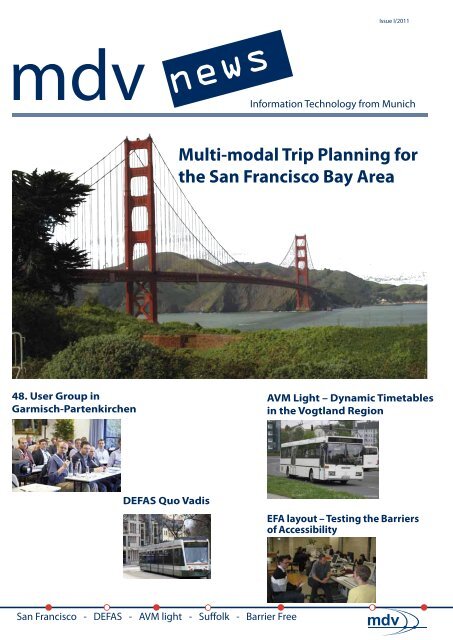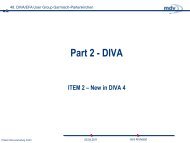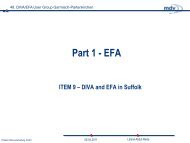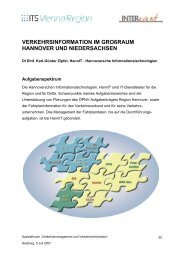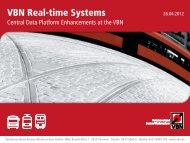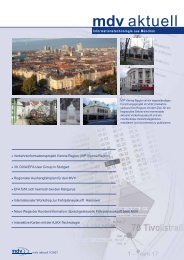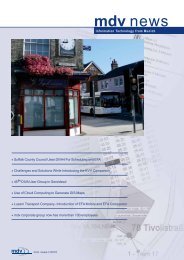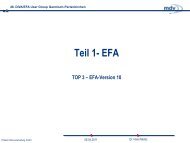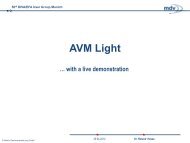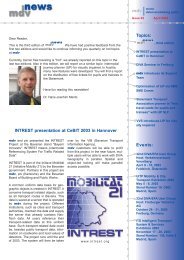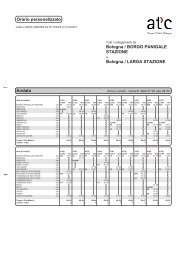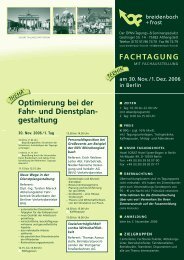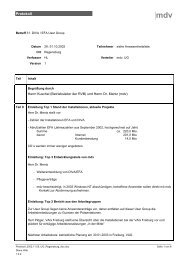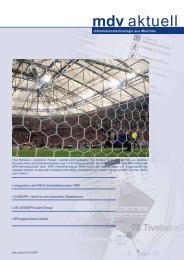Multi-modal Trip Planning for the San Francisco Bay Area - Mentz ...
Multi-modal Trip Planning for the San Francisco Bay Area - Mentz ...
Multi-modal Trip Planning for the San Francisco Bay Area - Mentz ...
You also want an ePaper? Increase the reach of your titles
YUMPU automatically turns print PDFs into web optimized ePapers that Google loves.
mdv <strong>Multi</strong>-<strong>modal</strong><br />
48. User Group in<br />
Garmisch-Partenkirchen<br />
DEFAS Quo Vadis<br />
news<br />
<strong>San</strong> <strong>Francisco</strong> - DEFAS - AVM light - Suffolk - Barrier Free<br />
Issue I/2011<br />
In<strong>for</strong>mation Technology from Munich<br />
<strong>Trip</strong> <strong>Planning</strong> <strong>for</strong><br />
<strong>the</strong> <strong>San</strong> <strong>Francisco</strong> <strong>Bay</strong> <strong>Area</strong><br />
AVM Light – Dynamic Timetables<br />
in <strong>the</strong> Vogtland Region<br />
EFA layout – Testing <strong>the</strong> Barriers<br />
of Accessibility
2 mdv news I/2011<br />
Letter from <strong>the</strong> Editor Contents<br />
Dear Reader,<br />
<strong>the</strong> production of this issue of mdv<br />
news has taken longer than originally<br />
planned. This is due in part to<br />
<strong>the</strong> lengthy approval process<br />
required <strong>for</strong> <strong>the</strong> articles.<br />
As is <strong>the</strong> norm, <strong>the</strong> current issue<br />
reports on our biannual user group.<br />
This time we met a little closer to<br />
home (Munich) in Garmisch-<br />
Partenkirchen, which was <strong>the</strong>n still a<br />
candidate to host <strong>the</strong> 2018 Olympic<br />
Winter Games. The location provided<br />
a very pleasant, yet inspiring setting<br />
<strong>for</strong> all participants.<br />
The first article deals with <strong>the</strong> multi-<strong>modal</strong> trip planner in <strong>the</strong> <strong>San</strong><br />
<strong>Francisco</strong> <strong>Bay</strong> <strong>Area</strong>. These types of multi-<strong>modal</strong> in<strong>for</strong>mation systems have<br />
garnered world-wide interest, especially when real-time has been<br />
integrated.<br />
We report on progress in DEFAS, <strong>the</strong> state-wide real-time journey planner<br />
in Bavaria.<br />
Our first AVM Light System (automated vehicle monitoring) is now in live<br />
operation in <strong>the</strong> Vogtland Region of Germany. We report on this<br />
experience.<br />
Finally, we recently supplied a new system <strong>for</strong> asset management at<br />
public transport stops to England, where <strong>the</strong> Local Council is tasked with<br />
<strong>the</strong> upkeep of infrastructure.<br />
I hope you enjoy reading this issue<br />
Dr. Hans-Joachim <strong>Mentz</strong><br />
Imprint<br />
Publisher:<br />
<strong>Mentz</strong> Datenverarbeitung GmbH<br />
Grillparzerstraße 18<br />
D-81675 München<br />
Tel.: +49 (0)89 41 868-0<br />
Fax: +49 (0)89 41 868-160<br />
E-mail: mdv@m.mentzdv.de<br />
Internet: www.mentzdv.de<br />
Editor: Rosemarie <strong>Mentz</strong><br />
Design: Rosemarie <strong>Mentz</strong><br />
Our branch offices:<br />
<strong>Mentz</strong> Datenverarbeitung GmbH<br />
Westfalenstraße 224<br />
D-48165 Münster<br />
Tel.: +49 (0)2501 969-0<br />
Fax: +49 (0)2501 969-300<br />
E-mail: mdv@ms.mentzdv.de<br />
<strong>Mentz</strong> Datenverarbeitung GmbH<br />
Rotebühlstraße 121<br />
D-70178 Stuttgart<br />
Tel.: +49 (0)711 61 55 43-0<br />
Fax: +49 (0)711 61 55 43-30<br />
E-mail: mdv@s.mentzdv.de<br />
<strong>Mentz</strong> Datenverarbeitung GmbH<br />
Georgenstraße 22<br />
10117 Berlin<br />
Tel. +49 (0)30 200 77-056<br />
Fax +49 (0)30 200 77-260<br />
E-mail: mdv@b.mentzdv.de<br />
<strong>Multi</strong>-<strong>modal</strong> <strong>Trip</strong> <strong>Planning</strong> <strong>for</strong> <strong>the</strong> <strong>San</strong> <strong>Francisco</strong> <strong>Bay</strong> <strong>Area</strong><br />
DEFAS - Quo Vadis<br />
AVM Light – Dynamic Timetables in <strong>the</strong> Vogtland Region<br />
Suffolk County Council Uses New DIVA Features<br />
48 th User Group Meeting in Garmisch-Partenkirchen<br />
EFA layout – Testing <strong>the</strong> Barriers of Accessibility<br />
News in Brief<br />
Our subsidiary offices:<br />
<strong>Mentz</strong> Datenverarbeitung Austria GmbH<br />
Mariahilfer Strasse 77-79<br />
1060 Vienna, Austria<br />
Tel.: +49 (0)89 41 868-0<br />
Fax: +49 (0)89 41 868-160<br />
E-mail: mdv@mentzdv.at<br />
<strong>Mentz</strong> Datenverarbeitung Schweiz GmbH<br />
Badenerstrasse 530<br />
8048 Zürich, Schweiz<br />
Tel. +41 (0)43 81863-11<br />
E-mail: mdv@mentzdv.ch<br />
mdv Australia Pty. Ltd.<br />
ABN 22134144326<br />
PO Box 682,<br />
Templestowe, 3106<br />
Australia<br />
phone: +61 (0) 437 241 927<br />
e-mail: rowlands@mentzdv.de<br />
In co-operation with:<br />
mdv Transit & Traffic Solutions Inc.<br />
201 Post St, 7th Floor<br />
<strong>San</strong> <strong>Francisco</strong>, CA 94108<br />
USA<br />
Tel.: +1 415 901 4927<br />
http://www.mdvtts.com<br />
3<br />
6<br />
8<br />
10<br />
12<br />
13<br />
13/14
<strong>Multi</strong>-<strong>modal</strong> <strong>Trip</strong> <strong>Planning</strong> <strong>for</strong> <strong>the</strong> <strong>San</strong> <strong>Francisco</strong> <strong>Bay</strong> <strong>Area</strong><br />
After successfully launching <strong>the</strong> trip planner <strong>for</strong><br />
public transport in <strong>the</strong> <strong>San</strong> <strong>Francisco</strong> <strong>Bay</strong> <strong>Area</strong>,<br />
<strong>the</strong> Metropolitan Transportation Commission<br />
(MTC) is continuing <strong>the</strong> expansion of in<strong>for</strong>mation<br />
portal 511 (www.511.org) as part of <strong>the</strong><br />
Urban Partnership Program (UPP). mdv continues<br />
to work in cooperation with <strong>the</strong> FORTUNE<br />
500 Company SAIC (From Science to Solutions)<br />
and is developing a multi-<strong>modal</strong> trip planner<br />
within <strong>the</strong> scope of <strong>the</strong> current project as a<br />
subcontractor.<br />
Currently, <strong>the</strong> in<strong>for</strong>mation portal 511 by <strong>the</strong><br />
MTC provides travel in<strong>for</strong>mation <strong>for</strong> <strong>the</strong> nine<br />
counties in <strong>the</strong> region in <strong>the</strong> following four<br />
categories: trip planning <strong>for</strong> public transport,<br />
traffic in<strong>for</strong>mation, ridesharing and bicycling.<br />
Having such a stark division of categories does,<br />
however, not necessarily allow <strong>for</strong> a quick and<br />
direct comparison of <strong>the</strong> different modes of<br />
transport available.<br />
The future multi-<strong>modal</strong> trip planning portal will<br />
be run in parallel with <strong>the</strong> trip planner <strong>for</strong> public<br />
transport on its own servers and will also have<br />
an additional staging server. Having its own<br />
hardware infrastructure renders <strong>the</strong> benefit of<br />
changing to <strong>the</strong> newest and most powerful<br />
hardware based on a 64-bit operating system<br />
and not having to interfere in <strong>the</strong> regular operation<br />
of <strong>the</strong> existing trip planner. As a result, it<br />
is also possible to fulfill <strong>the</strong> elevated per<strong>for</strong>mance<br />
and central memory requirements which<br />
arise due to <strong>the</strong> use of new components specific<br />
to individual transport. In using a 64-bit<br />
operating system, <strong>the</strong> limit of 4GB administrable<br />
memory, which posed a critical challenge<br />
<strong>for</strong> 32-bit operating systems, can be exceeded<br />
without any issues.<br />
The new trip planning portal makes it possible<br />
to quickly and conveniently compare <strong>the</strong><br />
various <strong>modal</strong>ities of transport. And due to <strong>the</strong><br />
multi-<strong>modal</strong> arrangement, door-to-door trip<br />
planning can be planned and displayed in<br />
parallel <strong>for</strong> different scenarios. The three<br />
scenarios, <strong>for</strong> which <strong>the</strong> portal provides a direct<br />
comparison, are <strong>for</strong> trips on public transport, by<br />
car and using Drive to Transit.<br />
Scenario 1: Public Transport<br />
In order to compare different scenarios in <strong>the</strong><br />
multi-<strong>modal</strong> trip planning portal, one has to<br />
ensure that <strong>the</strong> range of functions and trip<br />
planning <strong>for</strong> public transport are indistinguishable<br />
from that of <strong>the</strong> existing trip planner. This<br />
is done by directly converting <strong>the</strong> timetable<br />
data and <strong>the</strong> existing configuration of <strong>the</strong> running<br />
systems. The timetable data are transferred<br />
without alteration from <strong>the</strong> staging<br />
server of <strong>the</strong> existing trip planner to <strong>the</strong> staging<br />
server of <strong>the</strong> multi-<strong>modal</strong> trip planner and, after<br />
an integration check, imported to <strong>the</strong> live<br />
servers of <strong>the</strong> multi-<strong>modal</strong> trip planning<br />
system.<br />
Scenario 2: Motorized Individual Traffic<br />
When comparing different transport <strong>modal</strong>ities<br />
in <strong>the</strong> U.S., <strong>the</strong> number 1 mode of transport<br />
must be taken into account. In fact, a 2005<br />
study by <strong>the</strong> U.S. Department of Transportation<br />
(Wikipedia, 2011) found that 82% of all passenger<br />
kilometers in <strong>the</strong> U.S. were covered by<br />
motorized individual transport.<br />
By integrating motorized individual transport<br />
into <strong>the</strong> in<strong>for</strong>mation portal, car trips can be<br />
immediately compared with o<strong>the</strong>r scenarios. In<br />
this way, users are able to weigh <strong>the</strong> advantages<br />
and disadvantages of <strong>the</strong> individual<br />
scenarios at a glance and can decide whe<strong>the</strong>r<br />
to take public transport <strong>for</strong> part of or <strong>for</strong> <strong>the</strong>ir<br />
entire trip.<br />
Yet one issue remains when making a comparison<br />
between motorized individual transport<br />
and public transport – <strong>the</strong> unrealistically short<br />
driving times that most trip planners use that<br />
are based on statistical speed values found in<br />
<strong>the</strong> GIS data. As a result of <strong>the</strong> sole use of one<br />
set of data, only one speed value is available <strong>for</strong><br />
all times of day and night. Obviously, this data<br />
does not reflect <strong>the</strong> actual traffic volumes at different<br />
times of day.<br />
Speed Profiles<br />
In order to counteract this effect, speed profiles<br />
can be taken into account when calculating car<br />
routes in <strong>the</strong> EFA system. In <strong>the</strong> <strong>Bay</strong> <strong>Area</strong>, data<br />
exist <strong>for</strong> <strong>the</strong> main traffic arteries (highways, freeways<br />
and motorways), making <strong>the</strong> integration<br />
of different speed <strong>for</strong> <strong>the</strong> different times of <strong>the</strong><br />
mdv news I/2011 - 3<br />
day and day types (e.g. weekdays, Saturday,<br />
Sunday and holidays) possible on <strong>the</strong>se road<br />
sections. Using this data, <strong>the</strong> IT algorithm can<br />
enter <strong>the</strong> corresponding speed into a trip calculation<br />
depending on traffic direction, time of<br />
day and current day type validation.<br />
Traffic Alerts<br />
A fur<strong>the</strong>r factor is traffic disruptions. The EFA<br />
system, using ICS components (Incident Capturing<br />
System), can receive, create, and edit incident<br />
messages <strong>for</strong> public transport and traffic<br />
alerts <strong>for</strong> IT, which can <strong>the</strong>n both be <strong>for</strong>warded<br />
to connected EFA systems.<br />
The multi-<strong>modal</strong> trip planner in <strong>the</strong> <strong>San</strong> <strong>Francisco</strong><br />
<strong>Bay</strong> <strong>Area</strong> employs a DATEX2 interface to<br />
receive traffic alerts in <strong>the</strong> ICS. After being successfully<br />
received, <strong>the</strong> ICS converts <strong>the</strong> DATEX2messages<br />
into internal AddInfo <strong>for</strong>mat and <strong>for</strong>wards<br />
<strong>the</strong>m to <strong>the</strong> registered EFA systems.<br />
Traffic alerts can be displayed and managed in<br />
<strong>the</strong> ICS (see Figure 1).<br />
The traffic alerts received by <strong>the</strong> EFA systems<br />
are integrated into car route calculation and, if<br />
<strong>the</strong> calculated route is affected, displayed in <strong>the</strong><br />
output (see Figure 2 and Figure 3). If a traffic<br />
alert contains a road block, <strong>the</strong> affected street<br />
section is avoided and a corresponding traffic<br />
alert is also not displayed (needed) in <strong>the</strong><br />
directions.
4 mdv news I/2011<br />
Figure 1: Management of traffic alerts received by<br />
DATEX2 in <strong>the</strong> ICS<br />
Figure 2: Integration of traffic alerts into <strong>the</strong> directions<br />
(shown in a test layout)<br />
Mapping Static and Dynamic Traffic Data<br />
A challenge when integrating traffic alerts and<br />
o<strong>the</strong>r in<strong>for</strong>mation relevant <strong>for</strong> IT-routing is <strong>the</strong><br />
various reference graphs. This problem was also<br />
confronted when developing <strong>the</strong> multi-<strong>modal</strong><br />
trip planner <strong>for</strong> <strong>the</strong> <strong>San</strong> <strong>Francisco</strong> <strong>Bay</strong> <strong>Area</strong>. Both<br />
<strong>the</strong> traffic alerts and <strong>the</strong> speed profiles are referenced<br />
to a network graph which is not identical<br />
to <strong>the</strong> network graphs of <strong>the</strong> multi-<strong>modal</strong><br />
trip planner. As a consequence, <strong>the</strong> additional<br />
in<strong>for</strong>mation cannot be accounted <strong>for</strong> when<br />
calculating car routes without converting<br />
location references.<br />
The GisImport and DivaGeo modules had to be<br />
enhanced to calculate a conversion table<br />
between two network graphs and feed <strong>the</strong> output<br />
into an ASCII file. This table is subsequently<br />
read by <strong>the</strong> ICS and ITProfileConverter applications<br />
and used to convert location references.<br />
As depicted in Figure 4, traffic alerts or characteristics<br />
cannot be displayed on ano<strong>the</strong>r network<br />
graph without a conversion table. Using<br />
<strong>the</strong> conversion table it is possible to show in<strong>for</strong>mation<br />
on <strong>the</strong> red line on one or more of <strong>the</strong><br />
green lines. Consequently, traffic alerts and<br />
speed values from <strong>the</strong> profiles can be integrated<br />
into <strong>the</strong> multi-<strong>modal</strong> trip planning<br />
portal without any loss of in<strong>for</strong>mation.<br />
Time-bound Tolls<br />
A fur<strong>the</strong>r challenge to be overcome was <strong>the</strong><br />
integration of time-bound tolls, which are specific<br />
to car routing in <strong>the</strong> <strong>Bay</strong> <strong>Area</strong>. All trips over<br />
<strong>the</strong> bay bridges of <strong>San</strong> <strong>Francisco</strong> require tolls in<br />
at least one direction and some tolls are even<br />
dependent on <strong>the</strong> time of day travelled and<br />
payment method used (cash or automatic easy<br />
pass). The data model of <strong>the</strong> dynamic IT algorithm<br />
was enhanced <strong>for</strong> this requirement and<br />
<strong>the</strong> directions now indicate <strong>the</strong> tolls due based<br />
on payment method and time of day.<br />
Scenario 3: Drive&Park and Kiss&Ride<br />
The last trip scenario <strong>for</strong> a comparison is<br />
requesting a Drive&Park or Kiss&Ride route over<br />
<strong>the</strong> multi-<strong>modal</strong> trip planning portal. In doing<br />
so, <strong>the</strong> EFA system ei<strong>the</strong>r automatically selects<br />
<strong>the</strong> best Drive&Park parking spaces or lets users<br />
choose a desired transition point <strong>for</strong> a<br />
Drive&Park or Kiss&Ride trip from a list of<br />
options.<br />
Figure 4: Mapping between two network graphs<br />
Parking Garages and Drop-off Points<br />
The parking garages and drop-off points <strong>for</strong> a<br />
Drive&Park or Kiss&Ride trip are converted into<br />
GIS data using <strong>the</strong> GISImport application. The<br />
parking garages and transition points constitute<br />
a new point layer in <strong>the</strong> GIS data that can<br />
be used save additional attributes relevant <strong>for</strong><br />
parking. Among o<strong>the</strong>r things, <strong>the</strong> number of<br />
parking spaces, <strong>the</strong> coordinates of <strong>the</strong><br />
entrances and exits, <strong>the</strong> average duration<br />
between entering and leaving <strong>the</strong> parking<br />
garage and o<strong>the</strong>r numerous in<strong>for</strong>mative attri -<br />
butes per parking garage are imported and<br />
saved in <strong>the</strong> GIS data.<br />
This in<strong>for</strong>mation can be subsequently integrated<br />
into <strong>the</strong> EFA system and requested with<br />
assistance from <strong>the</strong> EFAParkingServer (see Figure<br />
6). In order to automatically pre-select <strong>the</strong><br />
best Park&Ride parking spaces, <strong>the</strong> system uses<br />
an escalating proximity search. If no parking<br />
garages are found within a starting radius of 5<br />
miles around <strong>the</strong> trip origin, <strong>the</strong> search is incrementally<br />
widened until it reaches an indicated<br />
maximum.<br />
Automatic Selection of <strong>the</strong> Best Drive&Park<br />
Routes<br />
In <strong>the</strong> past, users were <strong>for</strong>ced to select from a<br />
list with preselected parking garages, be<strong>for</strong>e<br />
<strong>the</strong> EFA system could calculate and present a<br />
complete Drive&Park trip. This manual selection<br />
is now complemented in <strong>the</strong> multi-<strong>modal</strong> trip<br />
planning portal <strong>for</strong> <strong>the</strong> <strong>San</strong> <strong>Francisco</strong> <strong>Bay</strong> <strong>Area</strong><br />
by an automatic selection of <strong>the</strong> best<br />
Drive&Park routes <strong>for</strong> an indicated departure or<br />
arrival time.<br />
As depicted in Figure 5, <strong>the</strong> process of automatically<br />
selecting <strong>the</strong> best Drive&Park routes is a<br />
complex orchestration of <strong>the</strong> various EFA components.<br />
It begins with verification of trip origin<br />
and destination (EFALocationServer), continues<br />
with a search <strong>for</strong> Drive&Park parking spaces<br />
near <strong>the</strong> starting point of <strong>the</strong> trip (EFAParkingServer),<br />
a search <strong>for</strong> public transport stops<br />
near <strong>the</strong> parking spaces and close to <strong>the</strong> destination<br />
(EFAGISKernel), calculation of footpaths<br />
between parking garages and origin stops,<br />
between destination stops and <strong>the</strong> final trip<br />
destination (EFAITRoutingKernel) and <strong>the</strong>
Figure 3: Route display incl. traffic alert<br />
Figure 5: Display of parking options on <strong>the</strong> interactive map<br />
Location Server<br />
oder EFA GIS Kernel<br />
(bei Koordinate<br />
START<br />
EFA IT<br />
Routing<br />
Kernel<br />
Parkmöglichkeit 1<br />
Parkmöglichkeit 2<br />
Parkmöglichkeit 4<br />
EFA<br />
Parking<br />
Server<br />
EFA IT<br />
Routing<br />
Kernel<br />
HST S1<br />
HST S2<br />
HST S3<br />
HST S4<br />
HST S5<br />
HST S6<br />
EFA GIS<br />
Kernel<br />
EFA PT<br />
Kernel<br />
EFA GIS<br />
Kernel<br />
HST Z1<br />
HST Z2 ZIEL<br />
HST Z3<br />
EFA IT<br />
Routing<br />
Kernel<br />
LocationServer<br />
oder EFA GIS Kernel<br />
(bei Koordinate<br />
Figure 6: Interaction of EFA components by a P&R route search with automatic selection of parking options<br />
mdv news I/2011 - 5<br />
calculation of routes with public transport<br />
(EFAPTKernel). After all in<strong>for</strong>mation about <strong>the</strong><br />
individual segments has been ga<strong>the</strong>red, <strong>the</strong><br />
parking garages with <strong>the</strong> best total trip time<br />
can be selected and <strong>the</strong> entire routes calculated<br />
and displayed.<br />
Outlook<br />
A first version of <strong>the</strong> multi-<strong>modal</strong> trip planning<br />
portal <strong>for</strong> <strong>the</strong> <strong>San</strong> <strong>Francisco</strong> <strong>Bay</strong> <strong>Area</strong> will go<br />
online on December 1st, 2011 and hopefully<br />
build on <strong>the</strong> success of <strong>the</strong> trip planner <strong>for</strong> public<br />
transport.<br />
The next phase of <strong>the</strong> project includes <strong>the</strong> integration<br />
of real-time data <strong>for</strong> motorized individual<br />
traffic, of links and display of relevant public<br />
transport real time departure times and of a<br />
CO2 calculator <strong>for</strong> <strong>the</strong> different scenarios.<br />
mdv contact:<br />
Marc Ullrich<br />
Ullrich@mentzdv.de<br />
Tel.: +49 (0) 89 418 68-145
6 mdv news I/2011<br />
DEFAS Quo Vadis<br />
The last time DEFAS FGI BAYERN appeared in<br />
mdv news II/2009, we were at <strong>the</strong> very beginning<br />
of <strong>the</strong> project. Since <strong>the</strong>n, DEFAS BAYERN<br />
has lost three letters and been officially in operation<br />
since 1 July 2010. But <strong>the</strong> question is, can<br />
passengers tell <strong>the</strong> difference?<br />
The Portals<br />
The first portal, which was supplied by <strong>the</strong><br />
DEFAS BAYERN Background System, was<br />
already in operation in April 2010. Passenger<br />
in<strong>for</strong>mation systems were set up <strong>for</strong> <strong>the</strong> State<br />
Garden Show in Rosenheim by RoVG (Rosenheim<br />
Transport Authority) at three central stations<br />
in Rosenheim (Rail Station, City Center<br />
and Atrium). On <strong>the</strong>se in<strong>for</strong>mation boards, <strong>the</strong><br />
latest departures of <strong>the</strong> SVR (Rosenheim City<br />
Transport) and RVO (Upper Bavarian Regional<br />
Transport) were displayed. At first, DEFAS BAY-<br />
ERN could only provide scheduled times. However,<br />
with <strong>the</strong> development of AVM systems of<br />
<strong>the</strong> two companies, a shift to real-time is now<br />
possible.<br />
During this time, <strong>the</strong> German Telecom set up<br />
several public telephones around <strong>the</strong> Garden<br />
Show with displays (Ö-Tel) (see Fig. 1) which<br />
showed <strong>the</strong> current departures of <strong>the</strong> nearest<br />
stops (Fig. 2). The familiarity of <strong>the</strong> telephone<br />
keypad makes it easy to plan a journey, even <strong>for</strong><br />
those of us who are non-technical experts. The<br />
public telephones at <strong>the</strong> garden show were<br />
part of a pilot project. In <strong>the</strong> meantime, more of<br />
<strong>the</strong>se systems have been set up throughout<br />
Bavaria and <strong>the</strong> existing systems have been<br />
transferred to <strong>the</strong> DEFAS BAYERN Background<br />
System.<br />
Both <strong>the</strong> displays of <strong>the</strong> RoVG and <strong>the</strong> public<br />
telephones access <strong>the</strong> DEFAS BAYERN EFA XML<br />
interface.<br />
On 1 January 2011 <strong>the</strong> new regional timetable<br />
was followed by <strong>the</strong> first internet portal, which<br />
replaced <strong>the</strong> old one mainly based on <strong>the</strong><br />
Deutsche Bahn timetable <strong>for</strong> Baveria. The new<br />
timetable impresses with its heavily map-based<br />
layout. During input, users can select between<br />
entering text and using <strong>the</strong> map. Even when<br />
typing text, feedback can be seen directly on<br />
<strong>the</strong> map. The results page displays both a<br />
detailed view and a visualization of <strong>the</strong> currently<br />
selected journey on <strong>the</strong> map. Users can<br />
choose between a vector map, aerial photos<br />
and a hybrid display. In <strong>the</strong> future, a topographic<br />
map with elevation in<strong>for</strong>mation will be<br />
added.<br />
One new system feature is <strong>the</strong> visualization of<br />
vehicle positions on <strong>the</strong> map. Visualization<br />
in<strong>for</strong>mation is supplied to AVM Systems by <strong>the</strong><br />
VDV 453 VIS interface so that <strong>the</strong> current positions<br />
of <strong>the</strong> vehicles can be displayed directly<br />
on <strong>the</strong> map. Punctual vehicles are represented<br />
by a green arrow. Slightly and majorly delayed<br />
vehicles are displayed with an orange or red<br />
arrow. If <strong>the</strong> mouse is moved over one of <strong>the</strong><br />
vehicles, additional in<strong>for</strong>mation about <strong>the</strong> vehicle<br />
appears in a bubble such as route number<br />
and direction. Currently, visualization in<strong>for</strong>ma-<br />
tion is available in DEFAS BAYERN <strong>for</strong> <strong>the</strong><br />
Stadtwerke Augsburg and <strong>the</strong> Mobility Company<br />
Omnipart.<br />
Shortly after <strong>the</strong> release of <strong>the</strong> schedule <strong>for</strong><br />
Bavaria, two additional portals were added that<br />
might normally be considered somewhat<br />
exotic. The first is <strong>Bay</strong>erntext (see Figure 3) of<br />
<strong>the</strong> Bavarian Television network and <strong>the</strong> o<strong>the</strong>r<br />
is <strong>the</strong> cross-country portal of <strong>the</strong> German Ski<br />
Association. <strong>Bay</strong>erntext has been supplying current<br />
traffic in<strong>for</strong>mation <strong>for</strong> Bavarian highways<br />
and airports <strong>for</strong> a long time. More recently, <strong>the</strong><br />
current departure boards of <strong>the</strong> Munich and<br />
Nuremberg train stations have been added.<br />
According to statistics from <strong>the</strong> Bavarian Television<br />
Network, <strong>Bay</strong>erntext is an in<strong>for</strong>mation<br />
medium that continues to be highly popular in<br />
use, especially in generations that grew up<br />
without IPhones and <strong>the</strong> internet.<br />
The next change <strong>for</strong> <strong>the</strong> portal will be to move<br />
<strong>the</strong> major Bavarian transport authorities to<br />
DEFAS BAYERN. They all currently operate <strong>the</strong>ir<br />
own journey planning systems without realtime<br />
in<strong>for</strong>mation and, with only a few exceptions,<br />
are limited to <strong>the</strong>ir particular area. The<br />
groundwork <strong>for</strong> this move is already underway<br />
so that passengers now using <strong>the</strong> individual<br />
authority portals can benefit from <strong>the</strong> statewide<br />
real-time journey planning system in <strong>the</strong><br />
near future.<br />
Real-time<br />
Figure 1: Bavaria Journey Planner on public telephones Figure 2: Public telephone departure board Figure 3: <strong>Bay</strong>erntext<br />
The goal of DEFAS BAYERN is a comprehensive<br />
state-wide real-time journey planning system<br />
<strong>for</strong> passengers. For this to become a reality <strong>the</strong><br />
AVM system data have to be processed in VDV<br />
454 REF-AUS and AUS <strong>for</strong>mat. At <strong>the</strong> same time,<br />
vehicles are displayed made on <strong>the</strong> map, whose<br />
AVM system data are supplied in VDV 453 VIS<br />
<strong>for</strong>mat. When this issue went to press, <strong>the</strong> following<br />
suppliers had been integrated to <strong>the</strong><br />
real-time journey planning system:
- DB Fernverkehr<br />
- DB Regio<br />
- Stadtwerke Munich<br />
- Stadtverkehr Rosenheim<br />
- Stadtwerke Augsburg<br />
- Berchtesgadener Land Bahn<br />
Visualization of in<strong>for</strong>mation is available <strong>for</strong>:<br />
- Omnipart<br />
- Stadtwerke Augsburg<br />
The integration of real-time data is currently<br />
being prepared <strong>for</strong> <strong>the</strong> following suppliers:<br />
- DB Stadtverkehr <strong>Bay</strong>ern (OVF, RVO, RVA,RBO)<br />
- agilis (Dieselnetwork of Upper Franconia and<br />
E-network Regensburg)<br />
- <strong>Bay</strong>erische Oberland Bahn<br />
- Bavarian Regio Bahn<br />
In addition to real time <strong>for</strong> <strong>the</strong> journey planning<br />
system, <strong>the</strong> AVM systems can exchange realtime<br />
in<strong>for</strong>mation over DEFAS BAYERN. This is<br />
done via <strong>the</strong> VDV 453 ANS services to guarantee<br />
connections and over <strong>the</strong> VDV 453 PIS to<br />
supply displays at stops and stations.<br />
It is planned, among o<strong>the</strong>r things, to supply <strong>the</strong><br />
real-time in<strong>for</strong>mation of non-federally owned<br />
railways over DEFAS BAYERN to <strong>the</strong> DB Station<br />
& Service <strong>for</strong> displays at <strong>the</strong> stations of DB Station<br />
& Service in Bavaria.<br />
The Data Plat<strong>for</strong>m<br />
Not as noticeable <strong>for</strong> passengers, but vital <strong>for</strong><br />
data suppliers of DEFAS BAYERN, is <strong>the</strong> data<br />
plat<strong>for</strong>m. Via DEFAS BAYERN, <strong>the</strong> scheduled and<br />
real-time data can be bi-or multi-directionally<br />
exchanged with each o<strong>the</strong>r as well as being<br />
able to simultaneously maintain a common GIS<br />
database.<br />
The DEFAS BAYERN installation also includes<br />
mdv products such as <strong>the</strong> DDIP <strong>for</strong> real-time<br />
data and DIVA 4 <strong>for</strong> <strong>the</strong> scheduled data and GIS<br />
data.<br />
The scheduled data of <strong>the</strong> data suppliers are<br />
currently organized into 59 subnets in which<br />
each data supplier has its own subnet. These<br />
subnets may stretch across several counties, as<br />
is <strong>the</strong> case of transport associations, or be limited<br />
to private railway companies on a single<br />
route. The rights- and role model is based on<br />
this subnet structure. At first, a data supplier<br />
only has functions <strong>for</strong> <strong>the</strong>ir own subnet. If a<br />
bilateral agreement has been made between<br />
data suppliers regarding data management,<br />
rights can be appropriately expanded as<br />
required. All data suppliers of DEFAS BAYERN<br />
have access to <strong>the</strong> scheduled timetable data <strong>for</strong><br />
<strong>the</strong> entire State of Bavaria.<br />
Regarding scheduled data, DEFAS BAYERN is<br />
primarily concerned with ensuring quality. Creating<br />
<strong>the</strong> scheduled data is done in <strong>the</strong> planning<br />
tools of <strong>the</strong> individual suppliers. Data is<br />
<strong>the</strong>n supplied to DEFAS BAYERN using stan-<br />
dardized exchange <strong>for</strong>mats such as VDV 452 or<br />
DINO. Once <strong>the</strong>re, <strong>the</strong> data is integrated into a<br />
state-wide network and is checked <strong>for</strong> quality<br />
using <strong>the</strong> DMS (Data Management System) in<br />
DIVA4. This powerful tool provides users with<br />
automated verification and validation checks<br />
when editing and correcting data. In this way,<br />
double stops, missing or implausible coordinates<br />
and trips with excessive speed can be<br />
automatically recognized. A protocol of <strong>the</strong><br />
quality check is generated after each data supply<br />
so that <strong>the</strong> data can be corrected in <strong>the</strong><br />
planning tool.<br />
For smaller data suppliers with only a few<br />
routes and no separate planning tool, data can<br />
be entered directly into DEFAS BAYERN using<br />
DIVA Web Schedule.<br />
Access to DEFAS BAYERN is secured via <strong>the</strong> SSL<br />
VPN, which provides <strong>the</strong> advantage of being<br />
able to work from anywhere that has an internet<br />
connection, while maintaining <strong>the</strong> security<br />
of a VPN tunnel. User identification occurs with<br />
<strong>the</strong> username and password and with a token,<br />
which supplies timed-controlled numeric passwords.<br />
At <strong>the</strong> time of writing, a total of 43 users<br />
had access DIVA in DEFAS BAYERN.<br />
In <strong>the</strong> realm of real-time data, <strong>the</strong> DDIP works<br />
in both multiplex and proxy mode (see also<br />
mdv news 02/2010). In <strong>the</strong> proxy mode, <strong>the</strong><br />
DDIP provides <strong>the</strong> physical connection<br />
between AVM systems, where real-time data<br />
are exchanged over DEFAS BAYERN. This occurs<br />
partly <strong>for</strong> <strong>the</strong> purpose of guaranteeing connections<br />
(VDV 453 ANS) and of supplying displays<br />
(VDV 453 PIS). The multiplex mode is used to<br />
supply several journey planning systems from<br />
a single AVM subscription.<br />
Conclusion<br />
With <strong>the</strong> addition of all suppliers in Bavaria,<br />
DEFAS BAYERN will be now be in a position to<br />
serve a large section of <strong>the</strong> population, who can<br />
take advantage of a state-wide real-time journey<br />
planner on <strong>the</strong> portals of <strong>the</strong>ir trusted<br />
transport authorities.<br />
mdv contact:<br />
Christoph <strong>Mentz</strong><br />
mentzc@mentzdv.de<br />
Tel.: +49 (0) 89 418 68-155<br />
mdv news I/2011 - 7
8 mdv news I/2011<br />
AVM Light – Dynamic Timetables in <strong>the</strong> Vogtland Region<br />
The title of this article may pose a series of<br />
questions, even to <strong>the</strong> experienced mdv news<br />
reader. What is AVM Light? What do AVM and<br />
mdv have to do with one ano<strong>the</strong>r? And what is<br />
<strong>the</strong> Vogtland Region doing with this innovative<br />
technology?<br />
The idea to build AVM Light came about with<br />
<strong>the</strong> advent of powerful easy-to-use smart<br />
phones like <strong>the</strong> iPhone and Android phones.<br />
They provide enough processing power <strong>for</strong> <strong>the</strong><br />
functions of an AVM driver data terminal, can<br />
be easily installed in a vehicle, and are af<strong>for</strong>ded<br />
enough screen readability <strong>for</strong> use while driving.<br />
Newer phones would even provide an integrated<br />
GPS antenna <strong>for</strong> vehicle tracking. Yet real<br />
world use has shown that GPS antennas inside<br />
vehicles are much less reliable than an externally<br />
mounted device. Now <strong>the</strong>re are even<br />
off-<strong>the</strong>-shelf products of this kind as well.<br />
Behind <strong>the</strong> concept of AVM Light is <strong>the</strong> idea of<br />
having an AVM system without <strong>the</strong> hardware<br />
and vehicle installation. So <strong>the</strong> word 'light'<br />
mainly refers to <strong>the</strong> lack of hardware and its<br />
associated investment and maintenance costs,<br />
and not to its functionality.<br />
System Concept<br />
Regarding <strong>the</strong> vehicles, a distinction is made<br />
between those to be equipped with new data<br />
terminals and those that already have an<br />
onboard computer which only needs to be<br />
upgraded (see Figure 1).<br />
Vehicles without on-board computers will be<br />
equipped with two components, a GPS tracker<br />
and a PDA.<br />
The GPS Tracker is a GPS receiver with an<br />
antenna and integrated GPRS modem, which<br />
has been mounted on <strong>the</strong> roof of <strong>the</strong> vehicle<br />
and merely has to be connected to <strong>the</strong> vehicle’s<br />
electrical system. The GPS Tracker has its own<br />
SIM card and sends messages to <strong>the</strong> AVM system<br />
over <strong>the</strong> mobile network in customizable<br />
time intervals as soon as <strong>the</strong> vehicle is turned<br />
on. These messages indicate <strong>the</strong> GPS position,<br />
speed and direction of <strong>the</strong> vehicle as well as a<br />
vehicle-specific ID.<br />
In <strong>the</strong> vehicle, a PDA is installed on which <strong>the</strong><br />
application runs. Using this application, <strong>the</strong><br />
driver can log on at <strong>the</strong> beginning of <strong>the</strong>ir shift.<br />
AVM Light can work with or without block in<strong>for</strong>mation.<br />
The assignment of a vehicle to a trip or<br />
a block occurs when a driver logs on to a<br />
respective route/block.<br />
In addition to driver log on/off, vehicle and<br />
route registration, communication with <strong>the</strong><br />
center of operations occurs over <strong>the</strong> PDA. This<br />
is ei<strong>the</strong>r done via text messages or over <strong>the</strong><br />
telephone features of <strong>the</strong> PDA.<br />
Ra<strong>the</strong>r than having a GPS module in <strong>the</strong> PDA,<br />
using an external GPS track provides a number<br />
of advantages. Due to <strong>the</strong> high-quality antenna,<br />
receiver and installation on <strong>the</strong> vehicle roof, significantly<br />
more stable and reliable GPS reception<br />
can be achieved. Moreover, position and<br />
vehicle ID are sent whenever <strong>the</strong> vehicle is in<br />
operation, regardless of whe<strong>the</strong>r a route and<br />
driver are logged onto <strong>the</strong> system.<br />
In vehicles with on-board computers, position<br />
indication and log on/off communication <strong>for</strong><br />
routes have to be per<strong>for</strong>med by <strong>the</strong> on-board<br />
computer. Communication with <strong>the</strong> AVM system<br />
occurs over an interface that has been<br />
agreed upon by <strong>the</strong> manufacturer of <strong>the</strong><br />
computer.<br />
Control center<br />
Figure 2 shows <strong>the</strong> control center in correspondence<br />
with <strong>the</strong> DIVA / EFA system. It is from <strong>the</strong><br />
DIVA system that <strong>the</strong> AVM system is supplied<br />
with scheduled data via a VDV 452 interface.<br />
Based on <strong>the</strong> scheduled data and <strong>the</strong> current<br />
vehicle position, timetable <strong>for</strong>ecasts are calculated<br />
by <strong>the</strong> AVM system. The <strong>for</strong>ecasts are <strong>the</strong>n<br />
sent ei<strong>the</strong>r directly to EFA real-time or first to<br />
<strong>the</strong> DDIP via interfaces VDV 454 AUS and AUS-<br />
REF <strong>for</strong> use in <strong>the</strong> EFA journey planner. The vehicle<br />
positions are transmitted via <strong>the</strong> VDV 453<br />
VIS interface to EFA and to third parties over <strong>the</strong><br />
DDIP. The AVM system is also able to receive<br />
third party VDV 453 VIS to display <strong>the</strong>ir vehicles<br />
on <strong>the</strong> control center display.<br />
Both <strong>the</strong> application of <strong>the</strong> control center and<br />
<strong>the</strong> application <strong>for</strong> <strong>the</strong> vehicle data terminals<br />
run on <strong>the</strong> application server. Both applications<br />
are fully web-based. The control center application<br />
can be accessed in a browser on user workstations.<br />
The same applies to <strong>the</strong> use of vehicle<br />
data terminals, which also only require a<br />
browser on a PDA.<br />
Installation of AVM-specific software to user<br />
workstations or PDAs is not necessary.<br />
The applications on <strong>the</strong> application server communicate<br />
with <strong>the</strong> AVM system over a WCF<br />
interface. It is also possible to open this interface<br />
<strong>for</strong> communication between <strong>the</strong> AVM system<br />
and <strong>the</strong> on-board computers.<br />
Figure 1 Vehicle system Figure 2 Control center and data management system DIVA/EFA
In addition to AVM data, <strong>the</strong> control center<br />
application also requires map tiles, which are<br />
accessed directly from EFA. Depending on <strong>the</strong><br />
network connection, is may also be possible to<br />
mirror <strong>the</strong> map tiles on <strong>the</strong> AVM server.<br />
For <strong>the</strong> transport authorities using AVM Light,<br />
<strong>the</strong>re is an option to set up remote workstations<br />
of <strong>the</strong> control center. They access <strong>the</strong><br />
application of <strong>the</strong> control center over a browser<br />
on <strong>the</strong> user workstations. Depending on security<br />
requirements, <strong>the</strong>y ei<strong>the</strong>r require an internet<br />
connection or a VPN tunnel into <strong>the</strong> network<br />
of <strong>the</strong> AVM operator. The data that can be<br />
viewed by <strong>the</strong> VU's can be controlled by a system<br />
administrator using rights management.<br />
VMiV – Dynamic Journey <strong>Planning</strong> in <strong>the</strong><br />
Vogtland Region<br />
In <strong>the</strong> spring of last year, and in collaboration<br />
with its partners PSI and Vodafone, mdv was<br />
successful in its bid to supply an AVM system to<br />
<strong>the</strong> Vogtland Region. An AVM Light was provided<br />
<strong>for</strong> all public buses in <strong>the</strong> Vogtland<br />
Region with <strong>the</strong> goal to provide passengers in<br />
<strong>the</strong> Vogtland Region with a comprehensive<br />
supply of data with real-time, in addition to <strong>the</strong><br />
AVMs under development in <strong>the</strong> Vogtlandbahn<br />
and <strong>the</strong> DB Regio.<br />
With PSI, mdv has a partner that provides a<br />
wealth of experience in <strong>the</strong> field of conventional<br />
AVM systems, having already operated<br />
several display systems in <strong>the</strong> Vogtland Region<br />
<strong>the</strong>mselves. The decision to partner with Vodafone<br />
was a consequence of <strong>the</strong> Connect Network<br />
Test, in which Vodafone had by far <strong>the</strong><br />
best network coverage in <strong>the</strong> ZVV operating<br />
area.<br />
The distribution of work within <strong>the</strong> project was<br />
as follows. While Vodafone was directly commissioned<br />
by <strong>the</strong> ZVV to supply <strong>the</strong> mobile data<br />
terminals and to make <strong>the</strong> network available,<br />
PSI supplied parts of <strong>the</strong> background system on<br />
behalf of mdv. The system’s main job is to manage<br />
vehicle and driver data and to calculate<br />
real-time <strong>for</strong>ecasts. mdv developed new software<br />
<strong>for</strong> <strong>the</strong> control center and driver data terminals<br />
and was responsible <strong>for</strong> project<br />
management.<br />
The project itself started on a very ambitious<br />
time schedule to implement <strong>the</strong> technically<br />
complex AVM system. Starting on 1 July, <strong>the</strong>re<br />
are exactly five and a half months until final<br />
acceptance of <strong>the</strong> system in December. Despite<br />
<strong>the</strong>se constraints, <strong>the</strong> project is on track to be<br />
successfully completed within <strong>the</strong> allotted time.<br />
Since January, AVM Light has been integrated<br />
into <strong>the</strong> regular operation of participating bus<br />
operators. Starting in October 2011, <strong>the</strong> real<br />
time data will be made accessible to passengers<br />
with <strong>the</strong> re-launch of <strong>the</strong> ZVV website.<br />
In total, over 160 buses from six different companies<br />
have been equipped with AVM Light,<br />
including two Vogtlandbahn railcars.<br />
Conclusion<br />
With <strong>the</strong> introduction of AVM Light, mdv can<br />
now supply <strong>the</strong> full value chain of real-time passenger<br />
in<strong>for</strong>mation, from scheduling and monitoring<br />
to display in <strong>the</strong> portals. Time-consuming<br />
coordination between interfaces is no<br />
longer necessary.<br />
That is not to mention <strong>the</strong> five o<strong>the</strong>r major<br />
benefits that are inherent to AVM Light:<br />
- Low investment costs<br />
- Low operating costs<br />
- Short implementation period<br />
- Proven and robust hardware<br />
- Easy to enhance<br />
mdv contact:<br />
Christoph <strong>Mentz</strong><br />
mentzc@mentzdv.de<br />
Tel.: +49 (0) 89 418 68-155<br />
mdv news I/2011 - 9
10 mdv news I/2011<br />
Suffolk County Council Uses New DIVA Features<br />
In mdv news I/2010, we reported extensively<br />
about <strong>the</strong> east coast County of Suffolk – which<br />
belongs to <strong>the</strong>Traveline East Anglia Region –<br />
and which has been using DIVA 4 and EFA since<br />
2009 (http://www.mentzdv.de/uploads/media/<br />
mdvnews_I-2010.pdf).<br />
The project includes a number of work packages,<br />
which pertain to both EFA and DIVA. The<br />
DIVA work packages are:<br />
- Stop and Timetable Management<br />
- Asset Management<br />
- Print Products (multi-stop timetables, map<br />
products)<br />
- Electronic Bus Service Registration (EBSR)<br />
- Contract Management Portal<br />
- Management Reports<br />
- Mobile DIVA Admin<br />
- TransXchange / NaPTAN: Import / Export<br />
In <strong>the</strong> current issue we want to introduce two<br />
new modules in some detail and show how<br />
<strong>the</strong>y were integrated into <strong>the</strong> DIVA system. The<br />
modules are asset management and electronic<br />
bus service registration (EBSR).<br />
Asset Management<br />
In England, public transport is “deregulated”. As<br />
a consequence, <strong>the</strong> County Council is responsible<br />
<strong>for</strong> its infrastructure, especially <strong>for</strong> <strong>the</strong> stops.<br />
This means that <strong>the</strong> Council is required to moni -<br />
tor, repair and ensure that timetables are always<br />
up-to-date. To accomplish <strong>the</strong>se tasks, DIVA4<br />
provides a new management tool, which is now<br />
in use by <strong>the</strong> SCC (Suffolk County Council).<br />
In various workshops with <strong>the</strong> SCC, a decision<br />
was made to differentiate between two types<br />
of assets in DIVA4:<br />
-Attributes and<br />
- Assets.<br />
Attributes are simply data fields<br />
- Yes / no<br />
- Text box<br />
- Selection lists<br />
- Date or number<br />
However this type of attribute is restricted, it<br />
cannot have any sub-attributes, and it cannot<br />
be assigned any damage. Adding an attribute<br />
to a stop is very simple. In DIVA Web a list of<br />
all available attributes can be opened and a<br />
value <strong>for</strong> <strong>the</strong> attribute can be selected from<br />
<strong>the</strong> list. All of <strong>the</strong> predefined values can be<br />
entered by <strong>the</strong> local employee (see Figure 1).<br />
Figure 1: Attributes<br />
For more rare cases of o<strong>the</strong>r sub-attributes or<br />
damage, <strong>the</strong> second type of asset management<br />
was developed, as to not overburden<br />
<strong>the</strong> stop list.<br />
Assets<br />
Asset can, in turn, have attributes. When<br />
selecting <strong>the</strong> asset type, <strong>the</strong> relevant attributes<br />
are displayed. A value can be selected<br />
<strong>for</strong> each attribute (see Figure 2).<br />
Figure 2: Asset<br />
If damage is reported, it will be entered and<br />
managed in DIVA, and added to <strong>the</strong> assets. In<br />
Suffolk it was important to be able to enter<br />
detailed in<strong>for</strong>mation about <strong>the</strong> damage (who<br />
reported <strong>the</strong> damage when was it reported,<br />
when was it resolved, etc. see Figure 3). In <strong>the</strong><br />
asset summary, <strong>the</strong> status of <strong>the</strong> damage is<br />
clearly visible after an update. The same customization<br />
applies <strong>for</strong> both attributes and<br />
assets in that <strong>the</strong> assets types can be individually<br />
specified.<br />
It was very important <strong>for</strong> mdv to offer our customers<br />
maximum flexibility by allowing <strong>the</strong>m<br />
to define and enter attribute and asset types<br />
<strong>the</strong>mselves without having to rely on mdv.<br />
Figure 3: Damage
Electronic Bus Service Registration<br />
Electronic Bus Service Registration (EBSR) is <strong>the</strong><br />
second new module that has great significance<br />
to our customers in <strong>the</strong> UK. Any technically<br />
qualified operator - as described in <strong>the</strong> first article<br />
about Suffolk – can provide a regular service<br />
that was properly registered be<strong>for</strong>e <strong>the</strong> start of<br />
operations at <strong>the</strong> VOSA (Vehicle & Operator<br />
Services Agency). This registration, which was<br />
done by paper <strong>the</strong> past 30 years, can now be<br />
processed electronically using <strong>the</strong> EBSR integrated<br />
into in DIVA. In order to create a<br />
timetable, <strong>the</strong> stop codes of <strong>the</strong> national stops<br />
database must be used, <strong>the</strong> so-called NaPTAN<br />
codes (National Public Transport Access Nodes).<br />
In order to register <strong>the</strong> timetable, it has to be in<br />
TransXChange (TXC) <strong>for</strong>mat.<br />
The operator has a separate login <strong>for</strong> DIVA Web<br />
and can per<strong>for</strong>m <strong>the</strong> entire registration over <strong>the</strong><br />
web. No special software is required, only a<br />
standard web browser is needed to per<strong>for</strong>m <strong>the</strong><br />
various tasks (eg Internet Explorer).<br />
Registering a route is done in <strong>the</strong> following<br />
steps in which <strong>the</strong> operator is supported by an<br />
assistant.<br />
Figure 4: Creating a route on <strong>the</strong> map<br />
Figure 5: Creating a timetable<br />
- Create route registration<br />
- Formalities (company name, contact<br />
address, contact name, license number,<br />
etc.), <strong>the</strong>se data are preset.<br />
- Route in<strong>for</strong>mation (route name, route<br />
number, etc.)<br />
- Route type<br />
- Operating days<br />
- Sponsoring<br />
- Create route on map in DIVA Web (see<br />
Figure 4)<br />
- Creating a timetable in DIVA Web Schedule<br />
(see Figure 5)<br />
- Create TXC timetable files and send to <strong>the</strong><br />
VOSA in DIVA Web EBSR<br />
With <strong>the</strong> EBSR in DIVA, timetables can be created<br />
faster, error rates can be reduced and as a<br />
result costs can be lowered.<br />
Summary<br />
mdv news I/2011 - 11<br />
We have been working closely with project<br />
manager Ian Gray and <strong>the</strong> team in Suffolk to<br />
test <strong>the</strong> previously implemented modules. The<br />
goal is to develop <strong>the</strong> best solution <strong>for</strong> Suffolk,<br />
but one that can also be attractive <strong>for</strong> o<strong>the</strong>r<br />
customers.<br />
As part of this ambitious project, a range of new<br />
developments were introduced in DIVA and<br />
EFA. We look <strong>for</strong>ward seeing <strong>the</strong>m in use in<br />
Suffolk and beyond. Many thanks to Ian Gray<br />
and Angharad Murray and <strong>the</strong>ir team <strong>for</strong> <strong>the</strong><br />
constructive and friendly cooperation.<br />
mdv contact:<br />
Liliane Abdul-Reda<br />
abdul-reda@mentzdv.de<br />
Tel.: +49 (0) 89 418 68-170
12 mdv news I/2011<br />
48 th User Group Meeting in Garmisch-Partenkirchen<br />
In cooperation with <strong>the</strong> Bavarian Railway<br />
Company (BEG) mdv invited selected participants<br />
to attend <strong>the</strong> 48th DIVA / EFA User Group<br />
in Garmisch-Partenkirchen in early April.<br />
Approx. 80 participants from Germany, Austria,<br />
Great Britain and Switzerland convened in a<br />
sports and convention hotel at <strong>the</strong> edge of one<br />
of <strong>the</strong> well-known winter sports resorts to be<br />
in<strong>for</strong>med about new mdv software. The stunning<br />
mountain scenery with snow-covered<br />
peaks set <strong>the</strong> tone <strong>for</strong> <strong>the</strong> conference.<br />
At <strong>the</strong> beginning of <strong>the</strong> user group, Mr. Kord<br />
Simons, head of infrastructure, passenger in<strong>for</strong>mation<br />
and quality at stations in <strong>the</strong> BEG, gave<br />
an overview of <strong>the</strong> tasks and activities of <strong>the</strong><br />
BEG and <strong>the</strong> telematics initiative of <strong>the</strong> Free<br />
State of Bavaria, which is also <strong>the</strong> basis <strong>for</strong> <strong>the</strong><br />
statewide DEFAS FGI BAYERN project. A series<br />
of presentations followed in which new<br />
product developments were described, such as<br />
<strong>the</strong> data plat<strong>for</strong>m DDIP, which is already successfully<br />
in use with customers, and <strong>the</strong> new<br />
AVM Light by mdv. Ano<strong>the</strong>r presentation based<br />
on statistics illustrated <strong>the</strong> behavior of mobile<br />
phone application users, where <strong>the</strong> participants<br />
could learn a new thing or two. O<strong>the</strong>r presentations<br />
covered <strong>the</strong> projects introducing DIVA<br />
4 and EFA 10 in Sydney (Australia) and Suffolk<br />
(UK).<br />
A highlight of <strong>the</strong> first day was a behind <strong>the</strong><br />
scenes view of <strong>the</strong> journey planner <strong>for</strong> <strong>the</strong> 2012<br />
Olympic Games in London. Mr. Stuart Reynolds,<br />
a member of <strong>the</strong> Olympic Delivery Authority,<br />
described to <strong>the</strong> audience <strong>the</strong> challenges that<br />
<strong>the</strong> organizational committee has had to deal<br />
with to meet <strong>the</strong> mobility demands of Olympic<br />
Game visitors. As one might suspect, <strong>the</strong> EFA<br />
system plays a crucial role as a journey planner<br />
<strong>for</strong> Greater London. The system has been<br />
enhanced to include in<strong>for</strong>mation about <strong>the</strong><br />
sports venues and additional controls rules in<br />
order to avoid flow conflicts between Olympic<br />
visitors and daily commuters.<br />
After <strong>the</strong> ambitious day program, <strong>the</strong> participants<br />
were able to relax afterward by visiting<br />
<strong>the</strong> nearby Bavarian Castle of Linderhof. The<br />
first day came to a close at dinner, which took<br />
place in a fantastic location with a fabulous<br />
panoramic view. The venue provided more than<br />
a few opportunities to exchange in<strong>for</strong>mation<br />
and ideas with <strong>the</strong> o<strong>the</strong>r participants.<br />
On <strong>the</strong> second day, topics focused on <strong>the</strong> new<br />
developments in <strong>the</strong> DIVA4 system, such as <strong>the</strong><br />
creation of presentation and print products or<br />
<strong>the</strong> management of data <strong>for</strong> public transport<br />
stop assets. Mr. Christoph Herzog of BLIC<br />
Middle East gave a very entertaining presentation<br />
"DIVA in <strong>the</strong> desert", which described <strong>the</strong><br />
tasks required to build a public transport system<br />
in Abu Dhabi (United Arab Emirates). With<br />
photos of everyday life in <strong>the</strong> desert town, Mr.<br />
Herzog attempted to give an impression of <strong>the</strong><br />
traffic situation on <strong>the</strong> ground. To better organ-<br />
ize mobility in Abu Dhabi, DIVA 4 is used by <strong>the</strong><br />
local authorities <strong>for</strong> planning and administrative<br />
tasks. Listening to remarks on <strong>the</strong> traffic situation<br />
in a hot desert town in a hotel in <strong>the</strong><br />
Bavarian Alps may have seemed like a tale from<br />
1001 Nights to more than just a few<br />
participants.<br />
The conference ended at lunch, where <strong>the</strong><br />
many new impressions and valuable pieces of<br />
in<strong>for</strong>mation could be mentally digested.
EFA layout – Testing <strong>the</strong> Barriers of Accessibility<br />
Employees of <strong>the</strong> Vocational Training Center <strong>for</strong><br />
<strong>the</strong> Blind and Visually Impaired of <strong>the</strong> Regional<br />
Association of Westphalia-Lippe (LWL) in Soest<br />
helped test <strong>the</strong> new EFA layout of <strong>the</strong> Westphalia<br />
Transport Authority (WVG) under <strong>the</strong><br />
watchful eye of trainers. In part due to good<br />
contact between <strong>the</strong> Regional Transport Company<br />
WVG Ruhr-Lippe GmbH (RLG) and <strong>the</strong><br />
vocational training center, it was possible to test<br />
and evaluate <strong>the</strong> mdv’s new layout both by<br />
experts and users in order <strong>for</strong> its compliance<br />
with accessibility requirements. The blind and<br />
visually impaired also need to be able to com<strong>for</strong>tably<br />
use a journey planner. The instructor<br />
first explained <strong>the</strong> hardware and software with<br />
which <strong>the</strong> trainees could read and edit barrierfree<br />
web pages be<strong>for</strong>e <strong>the</strong> EFA-layouts were<br />
closely scrutinized.<br />
While <strong>the</strong> visually impaired can improve <strong>the</strong><br />
standard user interface as needed with appropriate<br />
software, <strong>for</strong> example by drastically<br />
increasing font sizes and converting colors, <strong>the</strong><br />
blind have to rely on <strong>the</strong> quality of <strong>the</strong> text version<br />
of <strong>the</strong> EFA layout. This includes both <strong>the</strong><br />
content of <strong>the</strong> layout and input fields as well as<br />
<strong>the</strong> menus and selection boxes. Users are able<br />
to hear <strong>the</strong> contents of <strong>the</strong> screen in syn<strong>the</strong>tic<br />
speech using a screen reader and can enter<br />
content using a Braille keyboard. The most<br />
important aspect is to have a clear structure<br />
and an appropriate labeling of fields. Careful<br />
programming facilitates <strong>the</strong> fast reading and<br />
page use with key combinations of <strong>the</strong> screenreader<br />
software. This software is available from<br />
several vendors (e.g. widespread JAWS - Job<br />
Access With Speech).<br />
In <strong>the</strong> actual testing of <strong>the</strong> EFA-text version in<br />
Soest, we found that this version was already<br />
very well adapted to <strong>the</strong> needs of <strong>the</strong> blind and<br />
News in Brief<br />
that it works well with a screen reader. Never<strong>the</strong>less,<br />
<strong>the</strong> instructor was still able to give a<br />
few recommendations as to how <strong>the</strong> EFA-text<br />
version could be fur<strong>the</strong>r optimized. In essence,<br />
it is often <strong>the</strong> little things, like <strong>the</strong> elimination<br />
of blank spaces or <strong>the</strong> use of skip links that<br />
make a website more convenient <strong>for</strong> <strong>the</strong> blind.<br />
But it can be said that Peter Brocks and Holger<br />
Topp gained one main insight during <strong>the</strong>ir visit<br />
to <strong>the</strong> Soest LWL Resource Center: For <strong>the</strong><br />
blind, <strong>the</strong> first impression counts when <strong>the</strong>y<br />
visit a website. Anyone who has experienced<br />
redundant and unstructured in<strong>for</strong>mation read<br />
at a high speed and in syn<strong>the</strong>tic language can<br />
definitely understand why this kind of page<br />
would not be visited a second time.<br />
mdv news I/2011 - 13<br />
Peter Brocks (mdv), Stephan Lehmann and Kai Lammert<br />
(LWL) test <strong>the</strong> new EFA layout in <strong>the</strong> training<br />
room of <strong>the</strong> Vocational Training Center <strong>for</strong> <strong>the</strong> Blind<br />
and Visually Impaired<br />
mdv contact:<br />
Peter Brocks<br />
brocks@mentzdv.de<br />
Tel.: +49 (0) 2501969-219<br />
Stephan Lehmann and Kai Lammert (LWL), Holger Topp (WVG) and Peter Brocks (mdv) in front of <strong>the</strong> Vocational<br />
Training Center building<br />
EFA qualifies <strong>for</strong> <strong>the</strong> 2012 Olympic Games<br />
The 2012 Olympic Games are set to take place<br />
in both Greater London and o<strong>the</strong>r sporting<br />
venues spread out across Great Britain. Those<br />
who know London are aware of <strong>the</strong> normal<br />
traffic situation in <strong>the</strong> bustling metropolis.<br />
During <strong>the</strong> Olympic and Paraolympic Games,<br />
<strong>the</strong> usual numbers of commuters and tourists<br />
will be multiplied by <strong>the</strong> thousands of event<br />
spectators. As such, one <strong>the</strong> major tasks of <strong>the</strong><br />
planning committee was to effectively channel<br />
crowds to <strong>the</strong> various Olympic venues, a job<br />
mainly handled by <strong>the</strong> Spectator Journey<br />
Planner on <strong>the</strong> official website<br />
(www.london2012.com). Recommendations <strong>for</strong><br />
individual transit are combined with those <strong>for</strong><br />
public transport, which has been given a<br />
prominent role on <strong>the</strong> site. The journey planner,<br />
which recommends <strong>the</strong> best route to <strong>the</strong><br />
venues, makes use of <strong>the</strong> Transport Direct System,<br />
a nation-wide journey planning system of<br />
<strong>the</strong> British Department <strong>for</strong> Transport. The<br />
Department normally relies on <strong>the</strong> EFA System<br />
<strong>for</strong> journey planning throughout Greater<br />
London and its neighboring regions. To prevent<br />
<strong>the</strong> masses of spectators and commuters from<br />
overloading <strong>the</strong> transit systems in London, <strong>the</strong><br />
EFA-System was enhanced to include special<br />
rules that send Olympic spectators along individual<br />
routes to <strong>the</strong>ir destinations at <strong>the</strong> various<br />
stadiums and sporting venues.<br />
The Spectator Journey Planner can be found at<br />
http://travel.london2012.com/SJPWeb/Pages/JourneyPlannerInput.aspx
14 mdv news I/2011<br />
News in Brief<br />
Erin meets EFA<br />
mdv won <strong>the</strong> tender <strong>for</strong> a National Inter<strong>modal</strong><br />
Journey Planner presented by <strong>the</strong> National<br />
Transport Authority of <strong>the</strong> Republic of Ireland<br />
(NTA). The journey planner, dubbed 'Transport<br />
<strong>for</strong> Ireland', will offer a classic web portal as well<br />
as a mobile phone and app version. DIVA4 and<br />
<strong>the</strong> DDIP will work in <strong>the</strong> background to<br />
process both static and real-time data. Data will<br />
be imported from <strong>the</strong> country’s two largest bus<br />
operators, Dublin Bus and Bus Eireann, as well<br />
as from Irish Rail services. Smaller operators will<br />
ei<strong>the</strong>r manage <strong>the</strong>ir data directly in DIVA Web<br />
or have it taken care of by <strong>the</strong> NTA.<br />
RBS orders DIVA Deployment<br />
The Regional Transport Company Bern<br />
Solothurn (RBS) has chosen to <strong>the</strong> purchase <strong>the</strong><br />
DIVA planning system through a tender<br />
process. The RBS transports more than 80,000<br />
passengers every day on four rail lines and 10<br />
bus lines in <strong>the</strong> Region of Bern Solothurn.<br />
With <strong>the</strong> acquisition of <strong>the</strong> DIVA Deployment in<br />
Worblaufen, <strong>the</strong> headquarters of <strong>the</strong> RBS, <strong>the</strong>y<br />
have now completed <strong>the</strong> chain of DIVA components<br />
from network planning to deployment. A<br />
specialty of this project is <strong>the</strong> recently experimental<br />
use of iPhones as MBAs (mobile operating<br />
assistants), which also communicate with<br />
DIVA Deployment.<br />
DIVA 4 at <strong>the</strong> VVS<br />
The first major transport authority in Germany,<br />
<strong>the</strong> Transport and Tariff Association of Stuttgart<br />
(VVS), switched from DIVA3 to DIVA4. Since<br />
September 2011, <strong>the</strong> entry of timetable data<br />
has been done using DIVA 4. All print media<br />
and EFA data are generated from DIVA4.<br />
We are pleased that <strong>the</strong> VVS, <strong>the</strong> third user<br />
behind DEFAS Bavaria and <strong>the</strong> Olympic Journey<br />
Planner (GB), has now gone live with EFA 10. We<br />
are grateful <strong>for</strong> <strong>the</strong> commitment of <strong>the</strong> employees<br />
at <strong>the</strong> VVS as well as <strong>for</strong> <strong>the</strong> good cooperation<br />
<strong>the</strong>y demonstrated during <strong>the</strong> comprehensive<br />
conversion to our new product generation.<br />
(v.li.) Herr Torlach und Herr Kappler vom VVS arbeiten<br />
mit DIVA 4<br />
Successful Partnership Extended<br />
Originally in 1988, DIVA and EFA were products<br />
developed toge<strong>the</strong>r with <strong>the</strong> MVV and VVS,<br />
being co-owned. In 2001, mdv took over <strong>the</strong><br />
shares of <strong>the</strong> authorities and has since <strong>the</strong>n<br />
been <strong>the</strong> sole owner. At that time, <strong>the</strong> authorities<br />
entered a 10-year user agreement, which<br />
governed <strong>the</strong> commitment of VVS and MVV <strong>for</strong><br />
any new mdv developments. This year, 10 years<br />
later, all participants are happy to continue <strong>the</strong>ir<br />
very positive cooperation, extending <strong>the</strong> contract<br />
<strong>for</strong> ano<strong>the</strong>r 10 years. The partnership of<br />
more than 20 years between MVV, VVS and mdv<br />
is an excellent example that even in <strong>the</strong> fastpaced<br />
IT industry long-term cooperation is not<br />
only possible, but can be very successful as well.<br />
Upcoming Events<br />
20/21 October 2011 in Bremerhaven<br />
49 th User Group<br />
Host:<br />
Transport Authority of Bremerhaven -<br />
Bremerhavenbus<br />
Zur Hexenbrücke 11<br />
27570 Bremerhaven<br />
IT-TRANS<br />
IT Solutions <strong>for</strong> Public Transport<br />
15 - 17 February 2012, Karlsruhe, Germany<br />
26/27. April 2012<br />
50 th User Group (international)<br />
in Munich<br />
InnoTrans 2012<br />
International Trade Fair <strong>for</strong> Transport<br />
Technology<br />
18 - 21 September 2012, Berlin


